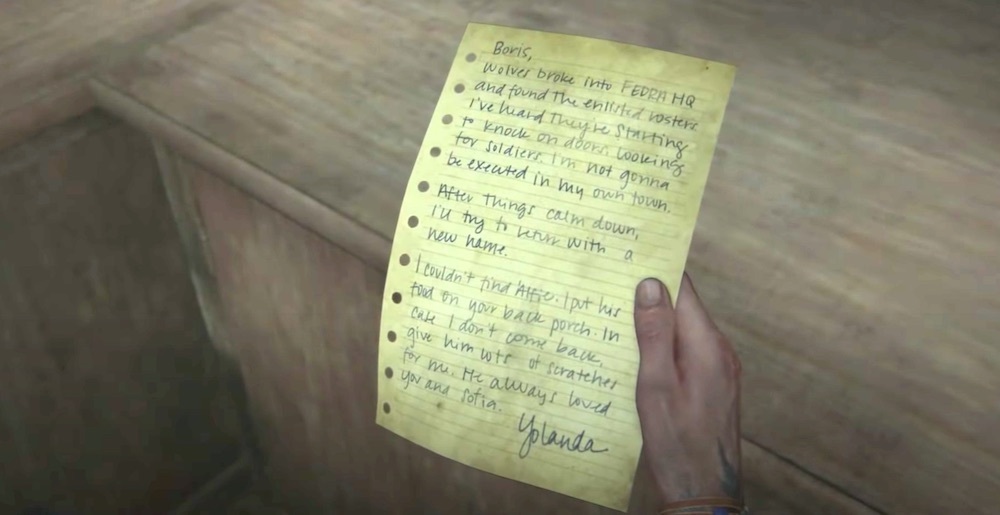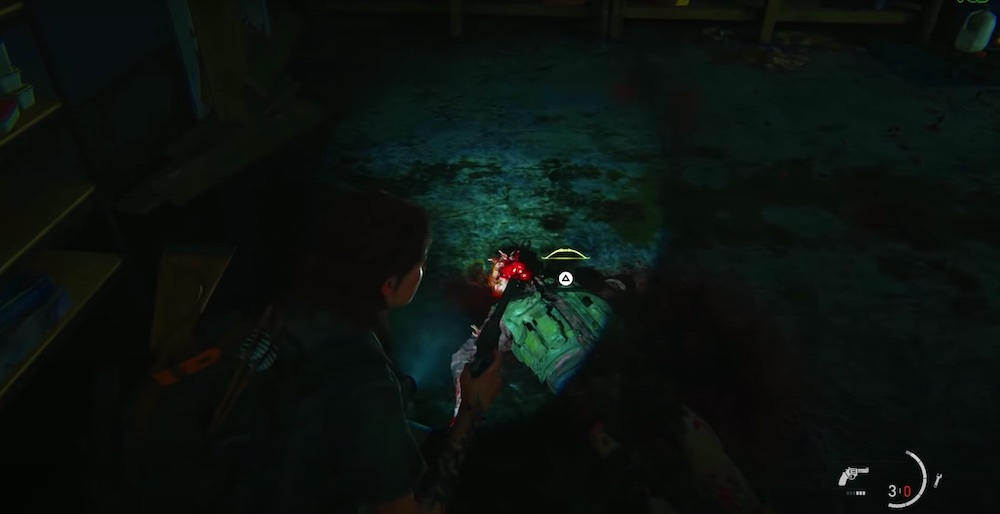There's a scene in The Last of Us Part 2 where, after approaching a workbench and dismantling your gun, you are mauled from behind by a group of rogue assailants. They have the upper hand, having quietly arranged a tactical formation on the dilapidated building's upper floor--they take cover behind sofas, kitchen counters, and half-open doors. But this shocking scene isn't all that surprising--or at least it wouldn't be, if you'd been reading the handwritten notes sporadically dotted across the surrounding town.
The Last of Us Part 2 weaves together a grimdark narrative filled with colour and noise, and yet, it teems with quieter, often untold stories contained within the pages of its virtual journaling. A man loses two sons to a radical religious cult because he was too afraid to leave the safety of their aquarium hideout, and dies sitting in the chair they berated him for never leaving; a parent passes away beneath the crumbling roof of a flooded factory, with medicine he never got to deliver to his sick family; a soldier whiles away his final hours behind the blast doors of a bank vault, dying to protect something that was not his own from a group of thieves seeking to capitalize on the maelstrom induced by the cordyceps outbreak. These are the quieter tales that The Last of Us Part 2's world is founded upon.
The stories of Ellie, Dina, Abby, and Lev are essential to The Last of Us Part 2's overarching narrative, but not necessarily to the construction of its wider world. They mirror it in unique ways and react to it at different times with distinct emotional responses, but their tales are likely no more significant than those we don't play through. This can be said of most stories: Just because Frodo bears the One Ring doesn't necessarily mean that his particular hardships are greater than those of anybody else--something that is particularly resonant in J.R.R. Tolkien's Lord of the Rings books, where Saruman returns to destroy The Shire, taking the lives of the nameless and unwritten in the process.
That's not a failure--storytelling often revolves around a small cast of characters in order to foster emotional investment, without which there are usually no stakes people deem worth reading or playing on for. The Last of Us Part 2 offers a clever solution to this by littering its suburban battlefields with notes and trinkets, adding historical context to places that history has already forgotten.

The best part about this structure is that it's completely optional. By no means do you have to read about a WLF deserter's slow descent into religious fundamentalism. It is not essential to learn about Seattle's many separated families attempting to reunite with one another by leaving trails of letters and heirlooms. However, choosing to invest time into these disparate tales allows you to understand the world of The Last of Us Part 2 in a more intimate way, which, in turn, heightens the stakes for everything precious to Ellie and Abby alike.
This is a world where people fail to save their loved ones despite sacrificing everything for them; where families turn on another for interpreting the creed of a martyred prophet in different ways; where a couple who once had kids and a golden retriever all tucked up in a little house on the prairie become common bandits, out of an odious cocktail of necessity, apathy, and pent-up hatred.
The way in which The Last of Us Part 2 revolves around this is meticulously well-designed. On one hand, people often complain about collectibles in games, stating that they can break immersion and distill tension. This is largely true, and there's a concrete argument to be made for that in relation to The Last of Us Part 2--I personally gave up on my quest to find every coin and trading card long before the end.
choosing to invest time into these disparate tales allows you to understand the world of The Last of Us Part 2 in a more intimate way
But the other collectibles are different. Whether you're playing Ellie or Abby, it's often in your best interest to read the notes withering away in derelict buildings. They could have a safe code scrawled across the bottom, permitting you access to valuable resources that are necessary for the progression of your odyssey across America. Or they could simply inform you of what happened years before you arrived in a place that has been deserted since the note was written--there's a solid chance you're the first person to ever read it, and the first person to be able to benefit from its contents as a result.
Once you learn that these notes are inherently intertwined with the landscapes you traverse, everything begins to change. Even when there are no words, The Last of Us Part 2's environments tell stories of their own.
For example, when Ellie arrives at Hillcrest after having left Dina behind at the theater, you start to discover notes referring to Boris, a person who has gone rogue and decided to go on a rampage around the surrounding area. Shortly afterwards, during a mini cutscene that plays as you attempt to enter a garage leading to the next street, you're ambushed by a feral Clicker. After you emerge victorious, you'll notice the bow on its back, accompanied by a full quiver of arrows--this, by implication, is Boris, who eventually fell victim to the cordyceps infection himself, and was probably completely unaware the bow he wreaked havoc with was still attached to his person.

There's even one section where you come across a partially fenced-off building. The door is barricaded with a dumpster--in some games you might think this is the environment telling you that you can climb on the roof. Or perhaps you're someone who just beelines towards the next waypoint--it's a dumpster, who cares?
In actuality, this dumpster is--and if you've been paying attention to the environments up until this point, it should be obvious--a cheap substitute for prison bars. When you approach it, you begin to hear the groans--the miserable wailing of the bitten who were confined here to live out their days as hungry, mindless Infected. Once you move the dumpster, their keening reaches a new pitch--this is the first time their meditative melancholy has been interrupted. Being in the know, I put down three trip mines before opening the door and retreating to a safe space.
As they emerged from the darkness of their makeshift cell, feeling the warmth of sunlight for the first time in weeks, or months, or years, I detonated the mines. Cruel, but necessary--I only had two bullets left, and there were dozens of WLF marauders between where I stood and my destination. I went inside, plundered the safe that had been of no use to the infected, and went on my way. As it turns out, there are various notes scattered amid the surrounding buildings alluding to the fact these poor souls had been herded here to live out their days in captivity, but the partially-written tales of misery and woe contained in said notes remain unfinished until you arrive to emphatically finish them--to put the nail in the coffin, so to speak.
It is the tantalizing pull towards exploring every nook and cranny in The Last of Us Part 2 that allows us to learn some of its most intriguing stories
Whether it's a note written to a lost love, a trinket left for posterity, or a conveniently-placed dumpster, street lamp, or burnt-out-car, there is nothing in The Last of Us Part 2's environments that is placed without intent. At face value, it may seem as if buildings and landscapes are populated with crafting materials, trading cards, and coins purely to promote exploration and reward you for spending time drinking in the scenery--but there's more to it than that.
While I agree that some of the more trivial trading cards may purely be the passion of the most intense trophy hunters, it is the tantalizing pull towards exploring every nook and cranny in The Last of Us Part 2 that allows us to learn some of its most intriguing stories. Most are miserable, if not downright harrowing--but every so often, once in tens of notes, there is hope. It may be modest, and it may have since fizzled out, but it's only after committing to reading the tragedies of countless people that you finally come across that one tale dashed with a slight, but tangible optimism. And that makes the world of The Last of Us Part 2 make sense in a way that the story never explicitly addresses, but absolutely and intentionally accommodates for.
The environmental storytelling of The Last of Us Part 2 isn't just some optional addendum you undertake to pop a couple of trophies--it's a collection of distinct esoterica that enriches the entire experience. When you spend time learning about the characters you'll never meet, or see, or hear about again, you'll realize that there is humanity yet in this world, and that it's not something worth fighting for, but something it is necessary to come together for.